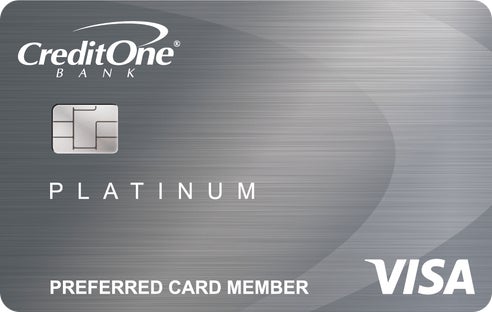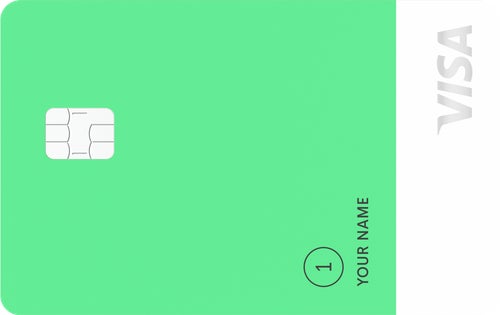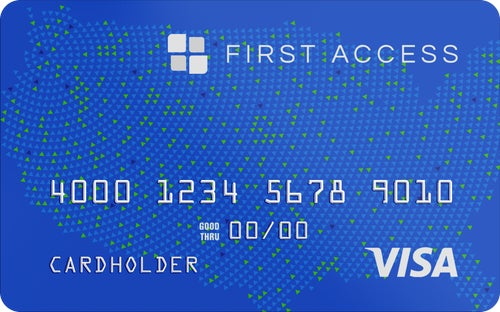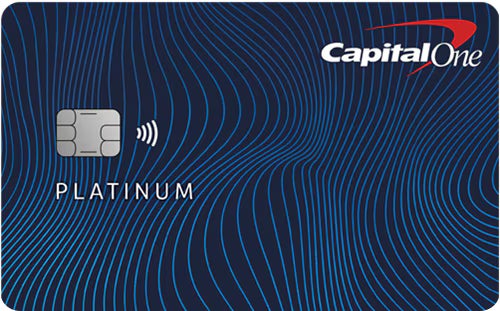| Credit Building Rating: | 1.5 / 5 |
| Cost of Membership | 1.0 |
| Ease of Building Credit | 3.5 |
| APR | 0.2 |
| Features | 2.3 |
In a Nutshell:
Due to its gargantuan fees and APR, the First Access Visa Card is tough to recommend – even for cardholders with severely damaged credit.
Average Cost Of Membership Per Year $106 |  |
Security Deposit Required $0 |  |
Initial Credit Limit $300 |  |
Access To Higher Credit Line? You can request a credit limit increase after 12 billing cycles |  |
APR 35.99% (Variable) |  |
Annual Fee $75.00 1st year, $48.00 after |  |
Other Rates And Fees See rates & fees |  |
Rewards None |  |
Other Notable Features: Request a credit limit increase after 12 billing cycles
If you have bad credit or limited credit history and are looking for a way to strengthen your credit profile without tying up money in a security deposit, an unsecured credit-building card may seem like your best way forward. You cannot only avoid putting down money upfront but also use your card to make purchases and, with responsible use, improve your credit over time.
Unfortunately, unsecured credit-building cards typically charge high fees and APRs, all while offering next to nothing in the way of rewards or cardholder perks. The First Access Visa Card no exception to this trend, and it’s also significantly more costly than many competing cards.
While the First Access Visa could theoretically work as a last resort for some credit-builders, you’ll almost certainly be better off working on your score with a credit-builder loan, a lower-cost unsecured card or, even better, one of the many secured credit cards that charge no annual fee.
See related: How long does it take to improve your credit score?
Rife with fees
The First Access Visa card’s most glaring shortcoming is its extremely high cost. Like many unsecured cards for people with damaged credit, the First Access Visa charges a high annual fee – but it doesn’t stop there. The card also charges a one-time program fee just for opening your account, as well as a monthly servicing fee (on top of your annual fee) after the first year. You’ll also be charged a fee for each additional card you request.
Check out the card’s terms for a full breakdown, and you’ll see how the First Access Visa card’s fees could pose a huge barrier for credit-builders on a budget. Indeed, since its fees may add up to more than the minimum deposit required on many secured cards, the First Access Visa loses nearly all its appeal as an unsecured card.
After all, any fees you pay as a First Access Visa cardholder are nonrefundable. With a secured card, at least, you can get your security deposit back when you close your account or, if applicable, upgrade to an unsecured version of the card. It should also be noted that this card requires you to have an active checking account.
Astronomical APR
Along with charging numerous upfront and ongoing fees, the First Access Visa carries a jaw-droppingly high APR, even for a card designed for someone with bad credit. The rate listed in the card’s terms is assigned to all cardholders, regardless of credit history, and currently rivals that of many store credit cards, which are infamous for their high APRs.
If you are looking for a long-term financing tool or otherwise have any doubt about your ability to pay off your balance in full each month, steer clear of the First Access Visa.
See related: Average credit card interest rates
Mediocre credit limit
Per the card terms, all First Access Visa cardholders receive a starting credit limit of $300 (though your initial available credit will drop immediately upon the assessment of the card’s annual fee). While $300 is a fairly common starting credit limit for cards designed with credit-builders in mind, many such cards at least offer a range of starting limits based on your credit history.
The unsecured Reflex® Platinum Mastercard®, for example, offers an initial credit limit of between $300 and $1,000 based on your credit history. A number of secured cards also offer high limits based on your deposit, with some offering limits of $2,000 or more.
That said, Bank of Missouri, the First Access Visa card’s issuer, does offer to review your account for a credit limit increase after you’ve had your card for at least 12 billing cycles. However, keep in mind that this is exactly when the card’s second-year fees start to kick in. What’s worse, if you accept a credit limit increase offer – even one you didn’t request – you’ll be charged an additional credit limit increase fee.
No noteworthy benefits
Aside from the minor benefits it offers as a standard Visa card, the First Access Visa is notably thin on cardholder perks. You can’t even use the First Access Visa outside of the U.S.
The card not only has no rewards program – which is fair enough given its primary function as a credit-building tool – but also lacks practical perks for credit-builders like free access to your score and budget management or credit education tools.
Building credit with the First Access Visa
The First Access Visa card reports to all three national credit bureaus, so if you pay on time and keep your card balance low, building credit with the card is definitely doable.
However, the card’s low starting limit may hold you back. That’s because your credit utilization ratio – the amount of money you owe relative to your total available credit – accounts for 30% of your FICO score. The lower your credit utilization, the better – but given the First Access Visa card’s low limit, everyday charges could quickly eat up a big chunk of your available credit.
On top of that, if you wind up carrying a balance, the card’s hefty APR could quickly get you into trouble, with mounting debt leading to missed payments.
With this in mind, consider using the First Access Visa card primarily for small charges you can pay off quickly, like a single subscription service. This approach will not only ensure you maintain positive payment history, avoid carrying a balance and are spared hefty interest charges but also help keep your credit utilization low.
Meanwhile, check out the various free tools you can use to monitor your credit score, such as the Credit Scorecard service from Discover, CreditWise from Capital One or Credit Journey from Chase.
First Access Visa approval odds
The First Access Visa is designed for cardholders with damaged credit, so even if your score falls in the “bad” or “poor” range (below 580 according to FICO) or you’ve been through a credit disaster like bankruptcy, you should have a chance at approval.
Unfortunately, however, Bank of Missouri does not offer preapproval for the First Access Visa via a soft credit pull. This means you’ll have to take a temporary score hit when you apply for the card, whether or not you’re approved.
See related: Pros and cons of ‘soft pull’ credit cards
How does the First Access Visa compare to other credit-building cards?
Stacked against other credit-building cards – secured and unsecured alike – the First Access Visa card falls short in nearly every category. The card charges very high upfront and ongoing fees, lacks any sort of rewards program and gives all cardholders the same unimpressive starting credit limit.
There are a number of credit-building cards that charge lower annual fees or make up some of their cost with other features. Consider these alternatives:
|  |  |
| Rewards rate None | Rewards rate 1% cash back on eligible purchases, including gas, groceries and mobile phone/internet/cable/satellite tv services | Rewards rate No consistent rewards (but offers 2% to 10% cash back at select local merchant) |
| Credit Limit $200-$1,000 (depending on your deposit) | Credit Limit Starting at $300 | Credit Limit $300-$5,000 |
| Annual fee $0 | Annual fee $75 for the first year. After that, $99 annually ($8.25 per month) | Annual fee $0 |
Other things to know
| Other things to know
| Other things to know
|
Capital One Platinum Secured Credit Card
Though it requires a security deposit, the Capital One Platinum Secured Credit Card will almost certainly be a less expensive credit-building option than the First Access Visa. Not only can you put down as little as $49 and still get a $200 credit limit, but you can also be considered for a credit line increase after six on-time monthly payments and may eventually be able to graduate to an unsecured Capital One card.
Credit One Bank® Platinum Visa® for Rebuilding Credit
Unlike the First Access Visa, the Credit One Bank Platinum Visa for Rebuilding Credit does not charge any setup or monthly maintenance fees. While the card’s annual fee may still be fairly expensive, you can offset some of this cost via the cash back you’ll earn on some of your everyday spending. Like the First Access Visa, this card is also unsecured, so no upfront deposit is required.
Petal® 1 “No Annual Fee” Visa® Credit Card
The Petal 1 card is a great option for cardholders with a limited credit history or subpar credit score who want a chance at a high credit limit. You can qualify for a limit as high as $5,000 based on your financial profile, and the issuer’s approval decisions can take into account alternative financial data like your income and bill payment history along with your credit score. The card also charges no annual fee and requires no security deposit.
Who should get the First Access Visa?
- Cardholders with damaged credit who want to rebuild credit.
- Cardholders who can’t afford to tie up money in a security deposit.
- Cardholders who plan to switch to a lower-cost card once their score improves.
- Cardholders who don’t anticipate needing to carry a balance from month to month.
- Cardholders who only plan to use the card for small purchases.
How to use the First Access Visa
- Keep an eye on your credit and switch to a card with fewer fees and better terms when your score improves.
- Keep your balances low and pay them off quickly to keep your credit utilization in check.
- Pay off your card balance in full each month to avoid high interest charges.
- Avoid adding authorized users, as each will incur a sizable fee.
Is the First Access Visa worth it?
Due to its high cost and limited benefits, it’s hard to imagine many scenarios in which the First Access Visa will be your best option. Credit-builders looking to minimize costs and build good financial habits should think twice before applying, as you can almost certainly find a lower-cost secured or unsecured starter card.
*All information about the Credit One Bank Platinum Visa for Rebuilding Credit card has been collected independently by CreditCards.com. The issuer did not provide the content, nor is it responsible for its accuracy.
All reviews are prepared by CreditCards.com staff. Opinions expressed therein are solely those of the reviewer and have not been reviewed or approved by any advertiser. The information, including card rates and fees, presented in the review is accurate as of the date of the review. Check the data at the top of this page and the bank’s website for the most current information.
Responses to comments in the discussion section below are not provided, reviewed, approved, endorsed or commissioned by our financial partners. It is not our partner’s responsibility to ensure all posts or questions are answered.

